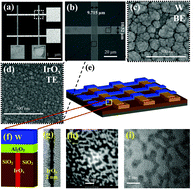Scalable cross-point resistive switching memory and mechanism through an understanding of H2O2/glucose sensing using an IrOx/Al2O3/W structure
Abstract
The resistive switching characteristics of a scalable IrOx/Al2O3/W cross-point structure and its mechanism for pH/H2O2 sensing along with glucose detection have been investigated for the first time. Porous IrOx and Ir3+/Ir4+ oxidation states are observed via high-resolution transmission electron microscope, field-emission scanning electron spectroscopy, and X-ray photo-electron spectroscopy. The 20 nm-thick IrOx devices in sidewall contact show consecutive long dc cycles at a low current compliance (CC) of 10 μA, multi-level operation with CC varying from 10 μA to 100 μA, and long program/erase endurance of >109 cycles with 100 ns pulse width. IrOx with a thickness of 2 nm in the IrOx/Al2O3/SiO2/p-Si structure has shown super-Nernstian pH sensitivity of 115 mV per pH, and detection of H2O2 over the range of 1–100 nM is also achieved owing to the porous and reduction–oxidation (redox) characteristics of the IrOx membrane, whereas a pure Al2O3/SiO2 membrane does not show H2O2 sensing. A simulation based on Schottky, hopping, and Fowler–Nordheim tunneling conduction, and a redox reaction, is proposed. The experimental I–V curve matches very well with simulation. The resistive switching mechanism is owing to O2− ion migration, and the redox reaction of Ir3+/Ir4+ at the IrOx/Al2O3 interface through H2O2 sensing as well as Schottky barrier height modulation is responsible. Glucose at a low concentration of 10 pM is detected using a completely new process in the IrOx/Al2O3/W cross-point structure. Therefore, this cross-point memory shows a method for low cost, scalable, memory with low current, multi-level operation, which will be useful for future highly dense three-dimensional (3D) memory and as a bio-sensor for the future diagnosis of human diseases.

- This article is part of the themed collection: 2017 PCCP HOT Articles


 Please wait while we load your content...
Please wait while we load your content...